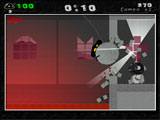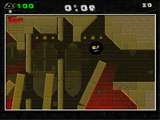Valve Releases Portal Teaser Trailer
Valve has released the video trailer for their recently-announced physics-based puzzle game, Portal. The game appears to be a new version of Narbacular Drop, a student project featured in the IGF Student Showcase last year. As mentioned in an interview with Gamastura:
GS: Do you (yet) have any success stories or positive experience based on showing the student game to people in the game industry (praise, actually getting a job in the biz, etc)?
Every year, DigiPen puts on an expo for the senior class to allow developers to take a look at our final projects. We were lucky enough to have the opportunity to speak with representatives of Valve and they were excited about what we were doing. Because of Narbacular Drop, our team is now collaborating with Valve.
Enjoy the video:
Gish, The Father of Physics Platformers
Chronic Logic’s Gish is probably the most well-known physics game on PC. It was an Independent Games Festival 2004 finalist, the grand prize winner in 2005, and has received a remarkable amount of gaming and mainstream press attention. In fact, I’d be surprised if Fun-Motion’s readers haven’t heard of Gish, so I won’t cover the basics of the game in too much detail.
Gish’s Physical States
Much of the gameplay in Gish revolves around changing the blob’s state (slick, sticky, and heavy). It’s a brilliantly elegant mechanic. Slick will allow Gish to worm his way through cracks, heavy is primarily used to smash enemies, and sticky allows him to climb walls and ceilings. The brilliance of it is using the states in combination, though.
For instance, you can throw loose blocks by grabbing them in sticky mode, rolling them on top and then hitting heavy and jumping. Slick and heavy combined allow Gish to slide down slopes at speed. Sticky and heavy can be used to hang on the underside of objects, such as levers, to pull them down. It takes awhile to learn to intuitively change between states, but this is where the meat of the interaction lies.
Shortcomings
Gish feels a little rough around the edges. It’s not very polished. It’s like development stopped just as soon as everything was working, rather than continuing with the express purpose of improving usability. There are a lot of small annoyances that pile up. It’s possible to accidentally fold Gish in on himself merely by jumping, which triggers instant death. Some small passages don’t have slopes leading into them, so it’s a pain in the ass to squeeze into them. The open-ended nature of the physics level design means it is possible to get into an unsolvable situation, even when simple precautions could prevent it. Jumping is frustrating. The list goes on.
Physics-Based Level Design
Where Gish absolutely excels is physics-based level design. Chronic Logic did a good job of incorporating physics contraptions into the levels. There are a large variety of obstacles including rope bridges, falling domino blocks, elevators, wrecking balls, and a host of variations. The highly physical nature of the levels makes playing the game a very dynamic experience.
The game includes a level editor, too, although unfortunately it’s very difficult to use. It’s a barebones tool the developers themselves used to create the levels. There is no UI for placing pieces; everything is driven by obscure keyboard shortcuts. It’s a damn shame the level editor was never redone with end-users in mind. There are some excellent user-made campaigns and single levels out there, but with proper tools the community would be able to create so much more. Most of the play time with Gish is actually spent learning, which involves a lot of replaying. Once you become skilled, the out-of-the-box game content can be burned through in an hour.
Sluggish
My main beef with Gish is that the game feels too sluggish. Not the controls, mind you. Rather, the entire game feels slow-moving. I think they could get away with increasing the timescale of everything by 30% and it would still be playable. Even this Gish speed run feels a bit slow (although it’s an amazing video in its own right, and well worth watching).
Classic Physics Game
Despite its faults, Gish absolutely deserves its accolades. It easily ranks among my favorite games. It’s a milestone in physics game design, and stands on its own merits alongside other classic platform games. A true console version would be amazing. Unfortunately, though, I doubt we’ll ever see Gish on something like Xbox 360 Live Arcade or a handheld. Alex and Edmund are still working on physics games with Alex’s new company, Cryptic Sea, so hopefully a spiritual successor to Gish will see the light of day.
In the meantime, play some Gish! If you’ve never tried the game you owe it to yourself to check it out. It can be frustrating at first, so make sure you set aside some time to really give it a fair shake. If you already own Gish, dust it off, grab some friends, and try out the multiplayer modes (they’ve added a few since the early versions of the game).
Download Gish Demo (11.4 MB)
The full version of Gish is $19.95 and available from Chronic Logic’s website.
Related Posts:
- Gish 2 Announced!
- Tantalizing Gish 2 Tech Video
- Gish 2 Development Begins
- The Beginning
- Blob Physics Article in Game Developer Mag
Portal, Valve’s New Physics-Based Puzzle Game
GameSpot and others are reporting on Valve’s recent announcements at EA’s summer press event. Team Fortress 2 was announced as a real, impending, bona fide product, which is kind of amazing in and of itself, but what caught my eye was Portal, a single-player game that will also be bundled with Half-Life 2: Episode Two.
The official press release describes Portal as:
Portal is a new type of single player game that changes how players approach, manipulate, and surmise the possibilities in a given environment in a manner similar to how the Gravity Gun changed our approach to how an object may be leveraged in any given situation.
Apparently, the gameplay revolves around a “portal gun”, which fires projectiles that open up into Prey-style portals. The GameSpot article describes one physics puzzle as:
That’s the simplest example of how to use the portal gun. In other situations, you may be under fire by a gun droid. So all you need to do is shoot a portal open over the gun, then shoot a portal open beneath a crate, then watch the crate fall through the hole and crush the gun.
The article also quotes Gabe Newell as saying, “We wanted to take physics out of this domain as a tool that lets you bounce grenades around to how can we really change the game experience for our customers.” Sounds amazing. Half-Life 2 is well-known for incorporating physics into the gameplay experience, so I can’t wait to see what Valve has up their sleeve. Look for a Portal trailer sometime early next week.


 (Rate this game! 367 votes, average: 4.08 out of 5)
(Rate this game! 367 votes, average: 4.08 out of 5)

 My name is Matthew Wegner, and this site is dedicated to physics games.
My name is Matthew Wegner, and this site is dedicated to physics games.